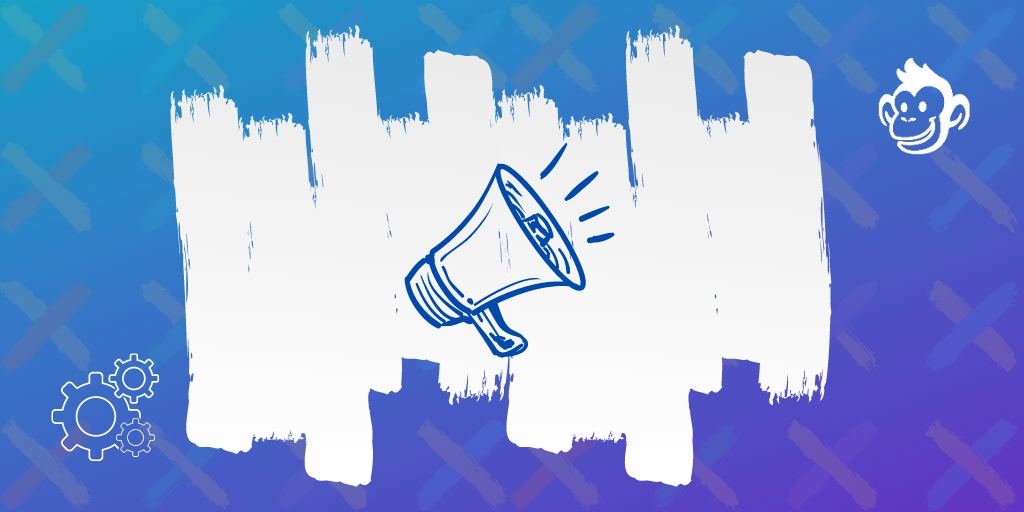The number of quality cross-channel marketing tools has increased along with the amount of easily accessible APIs, SDKs, and integration platforms.
Furthermore, as more marketing channels are able to “talk” to one another, the usefulness of cross-platform marketing tools has become more relevant.
So, what is cross-channel digital marketing?
Also known as omnichannel or multichannel marketing, cross-channel digital marketing software supports the delivery of campaigns across a variety of interactive channels.
Cross-channel marketing tools connect inbound and outbound, digital and non-digital campaign intelligence within a single platform. And in doing so, marketers are able to provide a seamless and consistent brand experience throughout the customer journey.
Some of the advantages of managing campaigns across channels through one solution consist of:
- Consistent communication with customers improves CX (customer experience), leading to increased customer lifetime value and brand advocacy.
- Easier to create a single cross-channel view of the customer, which provides actionable data for executing relevant cross-sells and upsells.
- Better performance in terms of marketing campaign metrics, such as CTR (click-through-rate) and conversions.
- Improved customer retention as well as acquisition, meaning a higher ROI on marketing expenditures.
- Cleaner metrics and more accurate ROI with omnichannel attribution
We’ve broken down the best 15 cross-channel marketing tools into the following categories:
- Chat marketing tools
- Email marketing tools
- Social media marketing tools
- SEO marketing tools
- Advertising tools
- Marketing automation tools
- Lead generation tools
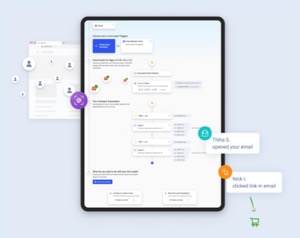
See Who Is On Your Site Right Now!
Get names, emails, phone numbers & more.
Try it Free, No Credit Card Required
Cross-Channel Marketing Tools for Chat
#1. Omnichannel chatbot marketing – Customers.ai
Customers.ai is an omnichannel chatbot that enables companies to proactively engage with audiences on their website, Facebook Messenger, SMS text messaging, and other popular web chat applications.
Using OmniChatⓇ technology and chatbot marketing automation, Customers.ai instantly connects customers and prospects to businesses in order to:
- Generate leads
- Re-engage customers, and
- Offer real-time, 24/7 chat support
This enables you to create campaigns such as chat blasts, conversational drip campaigns, as well as website chat dialogues one time, and then execute them across multiple marketing channels.
Cross-Channel Marketing Tools for Email
#2. Multichannel email marketing – MailChimp
MailChimp is one of the most popular email marketing platforms due to its ease of use and ability to create great-looking emails with a drag-and-drop user interface.
In addition to being the most recognized email marketing platform in the world, MailChimp has built out a suite of multi-channel marketing tools.

MailChimp now refers to itself as an “all-in-one marketing platform” with tools for:
- Email marketing
- Customer relationship management (CRM) dashboards
- Custom domains and website design templates
- Social media management and content scheduling
- Facebook and Instagram ad builders
- Landing page builders, including ecommerce
- Marketing analytics, and more.
MailChimp has gradually become more like Marketo, but for small businesses. And they’re doing this by building cross-channel marketing tools that complement their bread and butter, which is email.
Cross-Channel Marketing Tools for Social Media
#3. Multichannel social media management – AgoraPulse
Agorapulse is an all-in-one social media analytics dashboard and content scheduler that works across multiple platforms, including:
- YouTube
You can use AgoraPulse to gain audience insights and capitalize on otherwise missed opportunities with full monitoring and social media engagement tools.
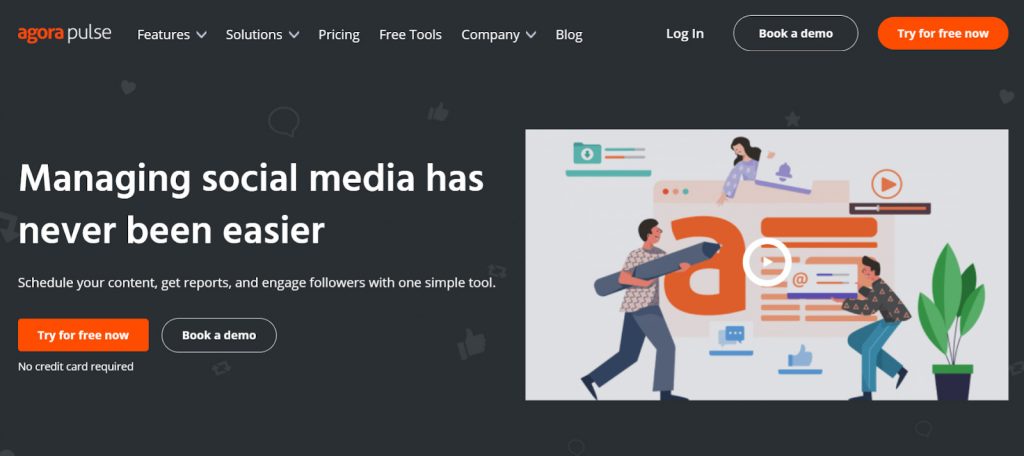
AgoraPulse has many options to build a pipeline for your content calendar. Additionally, you can store unlimited posts tied to particular themes, and queue them up for publishing.
Reporting and analytics are the two things that AgoraPulse does best.
It’s easy to export reports with key metrics and analysis on engagement and growth, and content reports let you identify posts that achieve the best reach, engagement, and clicks for any given period.
Lastly, you can use AgoraPulse to show your marketing team’s impact on conversions and revenue, as well as encourage more positive engagement with your ads across social channels.
Check out our list of the 18 best social media marketing tools to add to your marketing tech stack.
#4. Multichannel social media automation – MeetEdgar
MeetEdgar is similar to AgoraPulse but has a different superpower. While AgoraPulse’s strength is in its cross-channel social media analytics, MeetEdgar’s strength is in its fully automated, cross-channel content scheduling.
The best way to describe MeetEdgar is that it’s a content recycler for all of your most important (or evergreen) branded content.
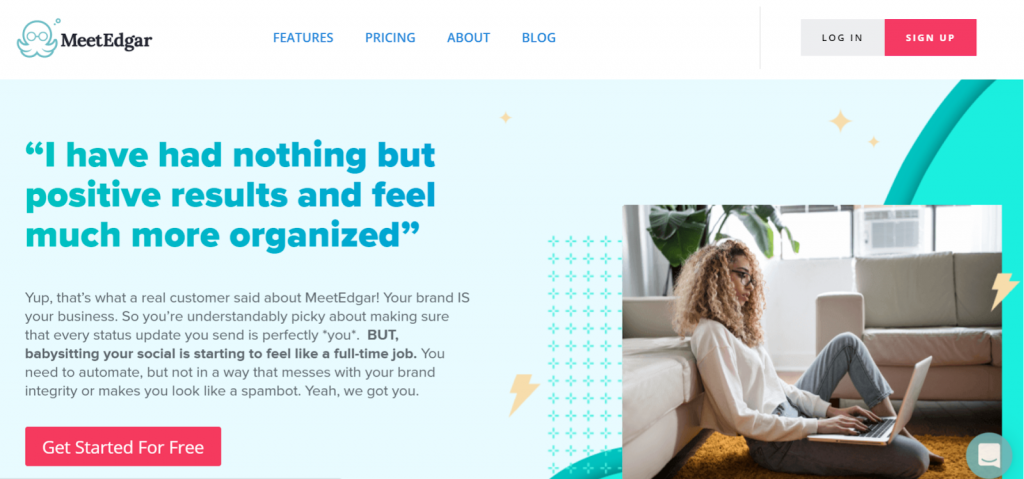
MeetEdgar automates the sharing of evergreen content across Facebook, LinkedIn, Twitter, and Instagram.
The time MeetEdgar will save you each week is what makes it one of my personal favorite social media marketing tools.
Unlike other content schedulers such as Hootsuite or Buffer, you can load MeetEdgar with your most important content one time, and then have that evergreen content shared over and over again on a set schedule.
In summary, use MeetEdgar’s cross-channel marketing tools for social media to do the following:
- Promote your best content, on a repeating schedule.
- Save your social media manager hours of time each week.
- Auto-generate and test variations of posts across Facebook, LinkedIn, Twitter, and Instagram.
- Schedule how many times per week, and on which days at which times you want each piece of content posted to each social media channel.
#5. Multichannel content insights – BuzzSumo
Digital marketers use BuzzSumo to reveal what content works and what content doesn’t perform across social media.
You can use BuzzSumo to get fresh content ideas and spend your time creating content that you know is going to perform well once it’s released into the wild. With the right workflow you can generate a lot of content this way.”

The BuzzSumo platform has four key components:
- Discovery tools help you explore high-performing content so you can get more likes, links, and shares.
- Research tools analyze billions of data points to sharpen your marketing strategy.
- Influencer tools help you identify influential people to power-up your brand or campaign.
- Monitoring tools track comments and trends so you can respond quickly and capitalize on opportunities.
#6. Multichannel social share buttons – AddThis
AddThis makes drag-and-drop share buttons that you can place on any web page.
For example, in the image below you’ll see their share buttons on the left-hand side of the AddThis homepage.
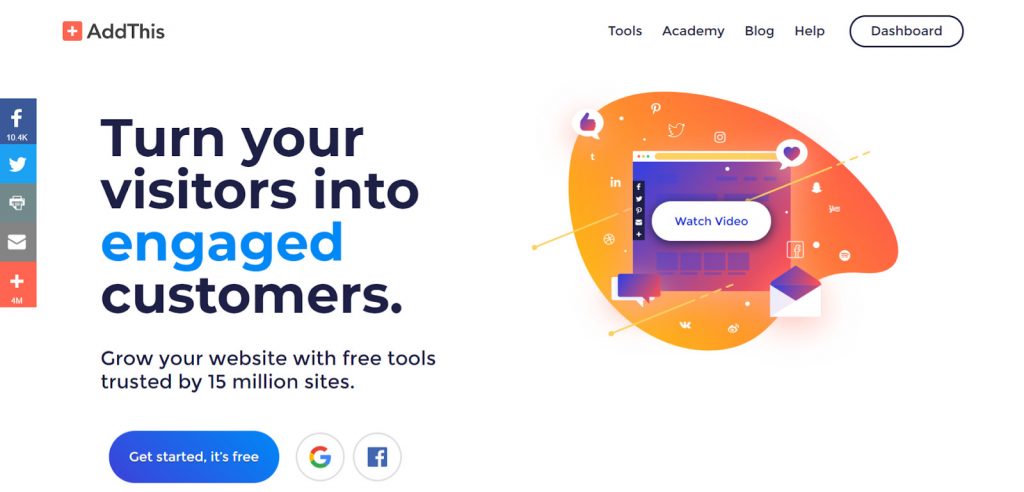
AddThis also offers web tools for list building, link promotion, and recommended posts.
You can use AddThis to:
- Make content shareable with drag-and-drop share buttons.
- Build your audience across multiple channels with auto-follow buttons.
- Increase site traffic by promoting your links and creating enticing calls to action.
#7. Facebook Messenger for business – Customers.ai
More than 1.5 billion consumers actively use Facebook Messenger chat. However, less than 1% of businesses are utilizing Messenger for business.
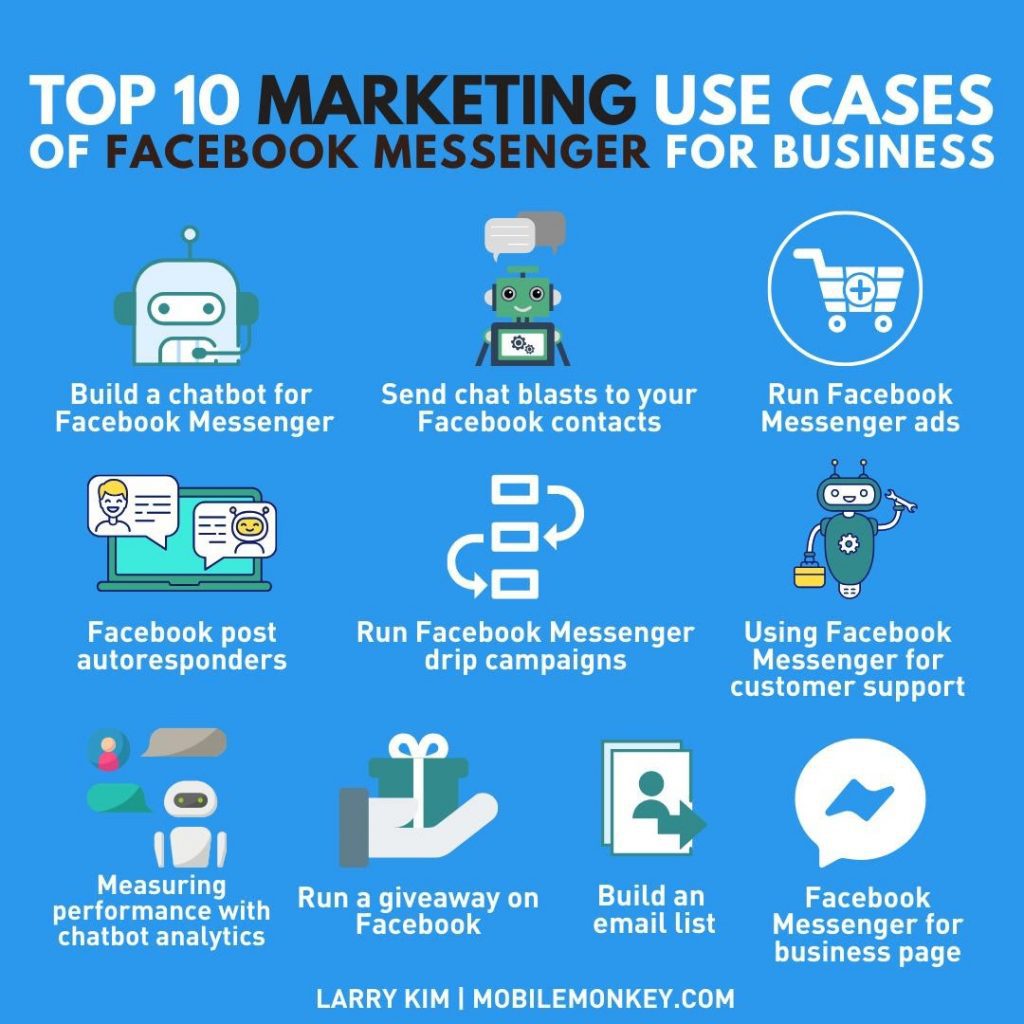
Furthermore, Messenger is trending because it’s compatible with chatbots for your website, and soon will be fully integrated into Instagram as well as WhatsApp.
Customers.ai Facebook Messenger chatbots allow you to engage with your audience with marketing automation tools such as:
- Chat blasting: Just like email blasts, but with chatbots
- One-time notifications: Invite users to get updates and promotional messages
- Drip campaigns: Sequenced messages across Facebook, SMS, and web chat
- Facebook post autoresponders: Capture leads and subscribers from organic Facebook posts
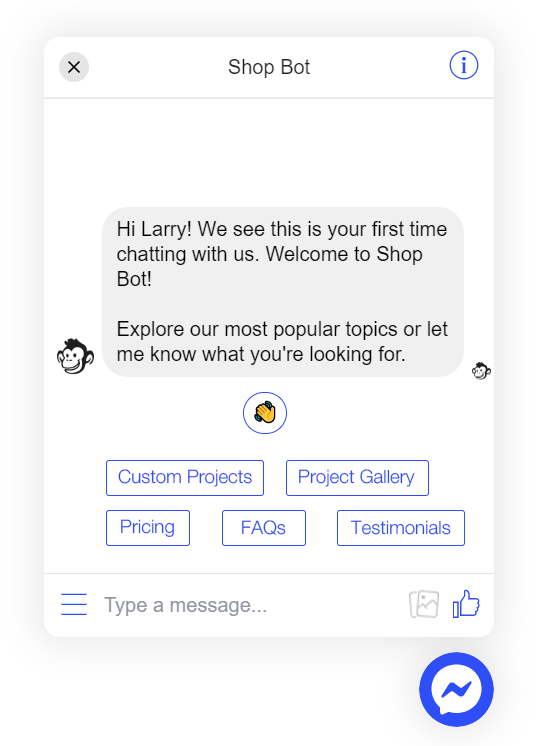
All the Messenger contacts captured by your Facebook Messenger bot can be added to other Customers.ai marketing channels. This includes SMS text messaging, native live chat for your website, and other web chat apps like Instagram and WhatsApp.
This way, you’ll be able to build user profiles, see their entire history across channels, trigger messages based on their behavior, and opt them into other campaigns.
Learn how to create a Facebook Messenger funnel that drives conversions.

See Who Is On Your Site Right Now!
Get names, emails, phone numbers & more.
Try it Free, No Credit Card Required
#8. Multichannel automation for social media – Phantombuster
Phantombuster provides over 200 code-free automation and data extraction tools across over 20 social platforms including:
- Zapier
- Medium
- Quora
Each tool can be used individually or combined with others to create full cross-channel marketing workflows.
For example, here’s a workflow that uses three different automation tools for lead generation on LinkedIn.
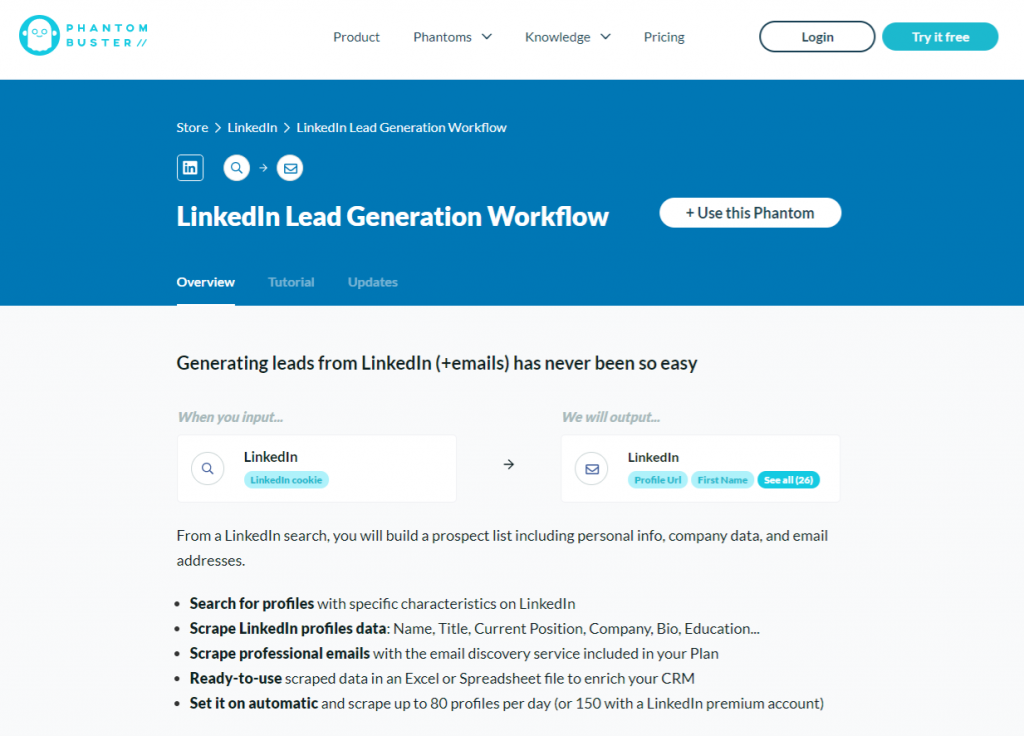
Use Phantombuster on your social media channels to:
- Generate leads
- Save time
- Build audiences
- Increase reach and engagement
Overall, Phantombuster is the most “growth hacker” like platform on this list. For more, check out these 15 awesome growth hacking tools used by top digital marketers.
Cross-Channel Marketing Tools for SEO
#9. Multichannel SEO marketing – SEMrush
SEMrush is the best all around SEO tool to make your brand visible online.
You can use SEMrush to supercharge your content marketing, improve SEO across your websites, create PPC campaigns, and manage your social media presence.
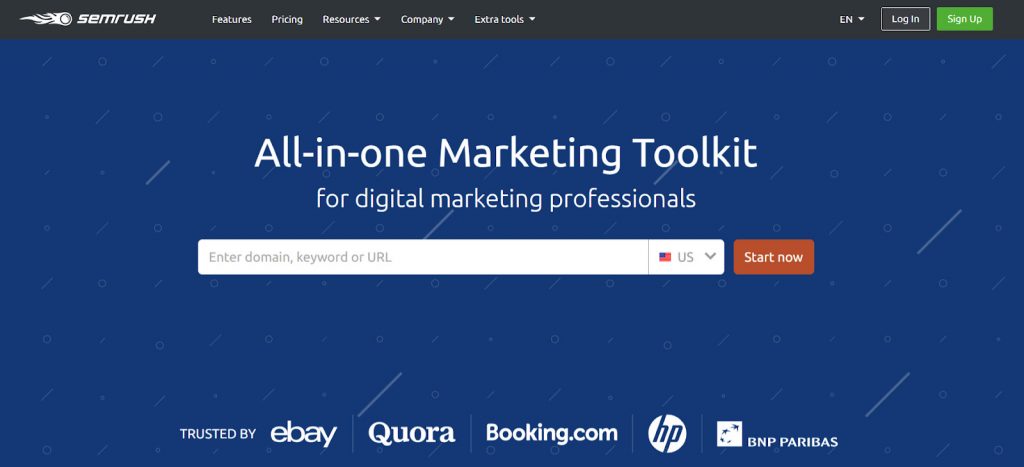
Some of the most popular tools to use on SEMrush are:
- Technical SEO audit
- Social media tracker
- Backlink audit
- Ad builder
- Keyword position tracking
- On-page SEO checker
- PPC keyword tool
- Organic traffic insights
SEMrush is useful for almost any marketing campaign. A few of their notable “extras” consist of tools built for specific verticals such as Traffic Jet, Amazon, affiliate marketing programs, and marketing agencies.
#10 Multichannel SEO & PPC marketing – SE Ranking
SE Ranking is one of the most versatile all-in-one tools that can help you go from 0 to 100 SEO-wise without much effort. The toolset is suitable for both newbies in the field and professionals, which is rare.
Some of the most used instruments by SE Ranking are:
- Keyword Rank Tracker
- Keyword Research Tool
- Competitor Analysis Tool
- On-Page SEO Checker
- Website Audit
- Backlink Checker
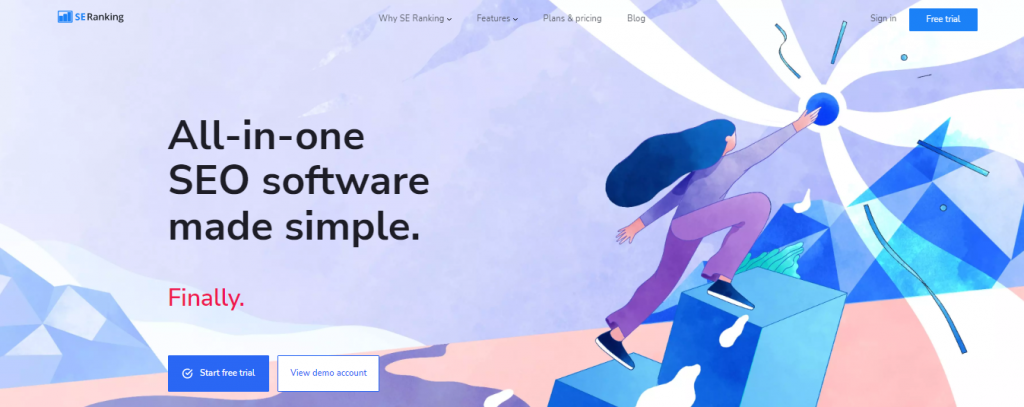
So, the set can cover most of your on-site and off-site SEO needs by showing all valuable data in handy expandable graphs and charts on one screen.
Besides, with SE Ranking you get social media management (SMM) or local marketing software if you need more than just website optimization. There are even more tools popular with small to middle businesses, agencies, SEO specialists, product managers, etc.
SE Ranking offers not just tools, it offers experience.
Cross-Channel Marketing Tools for Advertising
#11. Multichannel online advertising – AdEspresso
AdEspresso is for performance markers that need to manage hundreds of ads and ad variations at a time across multiple channels.
The AdEspresso platform has a combination of marketing automation tools designed to save you time while increasing conversions.
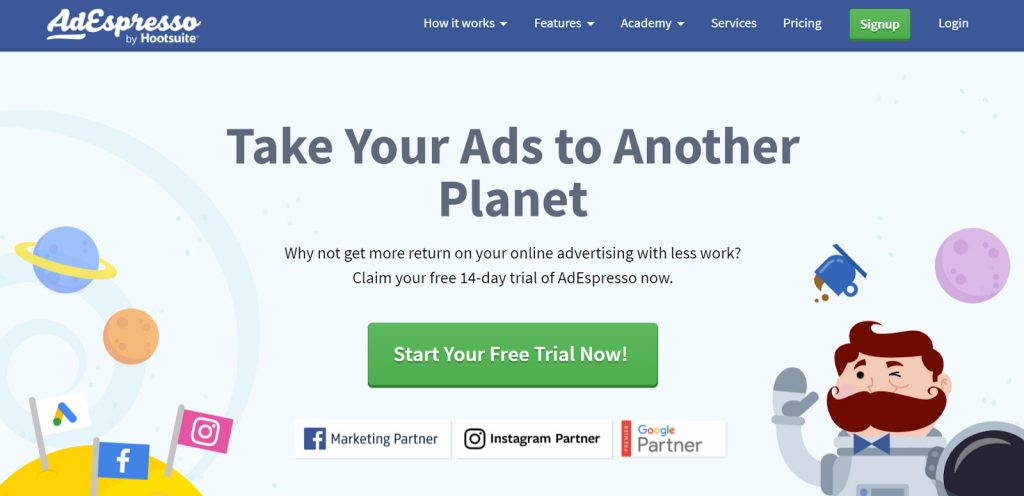
Using AdEspresso, you can quickly create and analyze your ad campaigns for Facebook, Instagram, and Google, all from one platform.
Running lots of Facebook ads?
Check out the top 7 Facebook ad hacks of all time to get ideas from one of the World’s top experts!
#12. Omnichannel online advertising – Customers.ai
One of the many marketing tools available from the Customers.ai OmniChatⓇ platform is built specifically for Facebook Messenger ads.
Before 2020 is over, even more Messenger ad tools will be available to serve to your audiences on Instagram, Facebook Shops, and possibly WhatsApp as well.
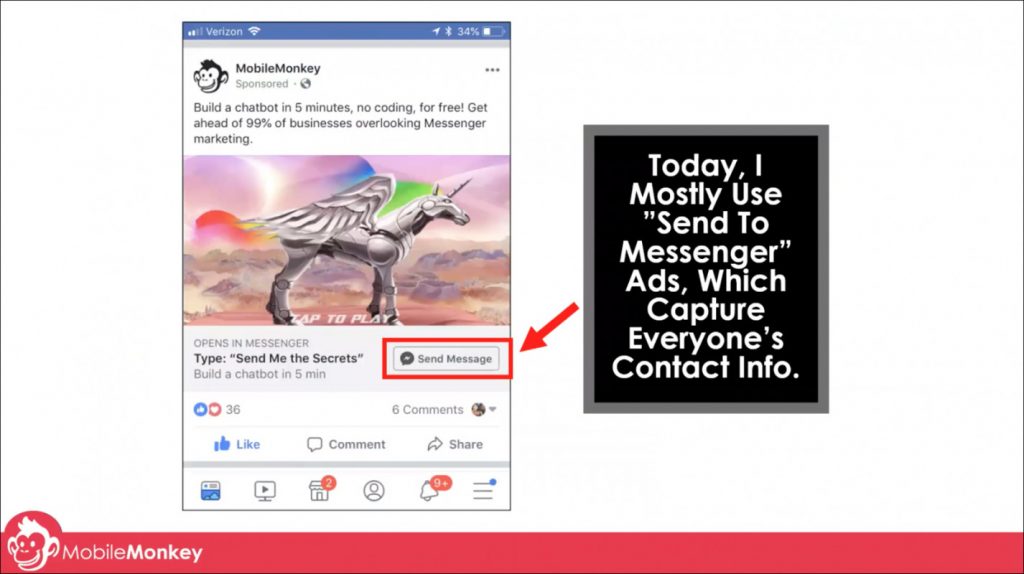
Messenger ads are a huge opportunity that savvy digital marketers are taking advantage of.
And that’s because Messenger ads are different from regular Facebook ads.
Even more important, Messenger ads perform better than your average Facebook advertising tools because they initiate engaging conversations with chatbots.
- Messenger ads outperform other ads by 2X-10X
- Instant lead and data capture
- More features available for personalization
- Automated lead qualification and follow-ups with chatbots
There are a couple types of Facebook Messenger ads. There’s click-to-Messenger ads, and then there’s sponsored messages that are native to Messenger.
Another cool thing about Messenger ad experiences is that they can take place across the Facebook family of apps. This includes Facebook newsfeed, Instagram newsfeed, Facebook and Instagram Stories, Marketplace, Messenger, and more.
Check out 19 different Facebook advertising tools you can use with Customers.ai.
Cross-Channel Marketing Tools for Automation
#13. Multichannel workflow automation – Zapier
Zapier is a great cross-channel marketing tool for creating automated workflows across your mar-tech stack.
Compatible with thousands of tools, Zapier allows you to easily chain commands together with an “If X happens, do Y” structure.
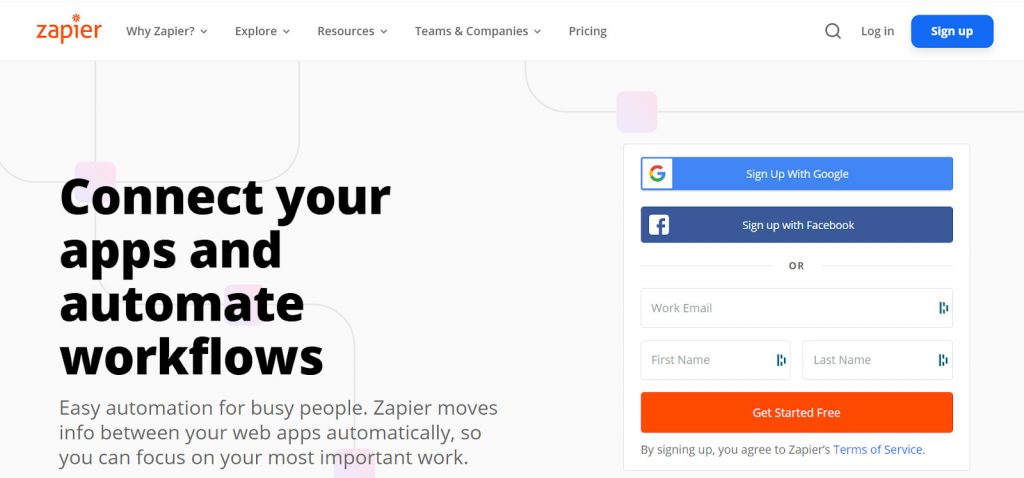
For example, the Customers.ai Zapier integration allows you to easily send information that’s stored to customer profiles in Customers.ai to other applications.
Here are just some of the most popular “Zaps” for Customers.ai users:
- Add all new leads to your CRM, such as Salesforce
- Send SMS messages or Slack notifications to new contacts
- Subscribe new Customers.ai contacts to MailChimp
- Register Customers.ai contacts to Zoom Webinars

Automation allows you to combine multiple actions and apps together in a single Zap.
Zapier will save you lots of time by automating repetitive tasks and please your clients when you’re able to work with their tech stack.
#14. Multichannel marketing automation – Autopilot
Autopilot is all about building a lead generation and lead nurturing process, and then making that process automated.
Using visual marketing automation, Autopilot makes it easy to design personalized customer experiences that capture and convert.

Autopilot allows users to:
- Customize journeys based on audience behavior.
- Build multi-channel workflows to send automated messages.
- Generate customer journey reports that allow you to fix leaky marketing funnels.
Autopilot also includes features such as measuring campaign ROI and optimizing the revenue funnel based on real-time performance.
Lastly, Autopilot integrates with other popular platforms such as Salesforce, InsideView, GoodData, Zapier, Slack, and Twilio.
Cross-Channel Marketing Tools for Lead Generation
#15. Multichannel lead prospecting data – Clearbit
Clearbit has rapidly become one of the most popular and powerful B2B marketing tools on the market.
In short, Clearbit is a marketing data engine for all of your customer interactions.
The Clearbit platform can be used to better understand your customers, identify future prospects, as well as personalize marketing and sales interactions.
Clearbit is a powerful multi-channel marketing tool that cross-references 250+ data sources and can segment audiences by nearly 100 unique tags.

Clearbit has three separate but integrated tools that make up its core components:
- Reveal: Unmask anonymous web traffic to personalize for target accounts
- Enrichment: Turn any email or domain into a full person or company profile
- Prospector: Discover your ideal accounts and leads with complete contact info
Keep in mind that Clearbit is not a cheap service, and if you don’t know how to use it, you can quickly run up the bill by acquiring too many leads.
That’s why you need to use the tool properly, identify highly target audiences, and then prospect in order to consistently fill your sales team’s pipeline with quality leads and data.
#16. Omnichannel lead generation software – Customers.ai
Most live chat software is only found on a company’s website. However, with OmniChatⓇ technology by Customers.ai, you can instantly talk to customers across multiple channels, including:
- Live chat for website
- SMS text messaging
- Facebook Messenger
- And soon to come – Instagram, WhatsApp, Apple Business

Customers.ai’s drip campaign features for web chat, SMS, Facebook Messenger, and other popular platforms allow you to set up a sequence of messages delivered at specified intervals.
Additionally, just like mass email marketing, Customers.ai has an automated, reliable method of sending mass content all at once to your audiences across multiple channels.
Check out its Facebook Messenger Chat Blaster feature, as well as its SMS Blaster to see how to send bulk messages in both Messenger and text messages.
You don’t have to worry about coding with Customers.ai either, because it offers marketing templates for every industry, and is built for both tech-savvy and non-tech-savvy marketers in mind.
Customers.ai is a great way to grow your contact list and generate leads. And one of its best features, autoresponders, can turn your social post commenters into leads.
The platform is fully integrated with a Facebook Comment Guard feature that allows you to automatically add contacts to your Messenger contact list each time someone comments on your post. All you need to do is to install the comment guard on your Facebook post.
In need of more marketing tools?
If you need even more marketing tools, we have a lot of categories for you to choose from. Browse through hundreds of marketing tools in the following lists:
- Free marketing software
- Tools for digital marketing agencies
- Marketing automation tools
- Trending digital marketing tools
- Social media marketing tools
- Ecommerce marketing tools
- Instagram marketing tools
- B2B marketing tools
- Viral marketing tools
- Marketing tools for small business
- Lead generation tools
- Growth hacking tools
- Conversion rate optimization (CRO) Tools
- Content marketing tools
- Affiliate marketing tools
- Marketing automation for agencies
- Email marketing tools

See Who Is On Your Site Right Now!
Get names, emails, phone numbers & more.
Try it Free, No Credit Card Required
Important Next Steps
Frequently Asked Questions
What are cross-channel marketing tools?
Cross-channel marketing tools are platforms that help marketers manage, coordinate, and analyze campaigns across multiple channels, such as email, social media, websites, SMS, and ads. These tools ensure consistency in messaging and a seamless customer experience across all touchpoints.
Why are cross-channel marketing tools important?
Cross-channel marketing tools are essential because they allow marketers to reach customers wherever they are and create unified, consistent messages that improve engagement, strengthen brand recall, and increase conversions. They streamline campaign management and provide insights into customer behavior across multiple platforms.
What types of channels can be integrated with cross-channel marketing tools?
Channels typically integrated include:
- Email Marketing: For personalized email campaigns.
- Social Media: For organic posts and paid social ads.
- SMS and Push Notifications: For direct, time-sensitive messaging.
- Paid Ads: Across platforms like Google Ads and Meta.
- Web Content: For website personalization and targeting.
How do cross-channel marketing tools improve customer experience?
By creating a cohesive experience across channels, these tools help brands maintain consistent messaging and respond to customer actions in real time. For example, a customer who browses an item online may receive an abandoned cart email reminder, followed by a social ad if they didn’t purchase.
What are some popular cross-channel marketing tools?
Examples include:
- Customers.ai: Offers visitor tracking, remarketing, and email outreach
- HubSpot: Offers CRM, email, social, and content management in one.
- Salesforce Marketing Cloud: Known for customer journey automation.
- Mailchimp: Includes email, ads, and social media tools.
- ActiveCampaign: Combines email, CRM, and automation for multi-channel campaigns.
How does segmentation work with cross-channel marketing tools?
Segmentation allows marketers to create specific audience groups based on demographics, behavior, and purchase history. With cross-channel tools, segmented audiences can receive personalized messages across channels, enhancing relevance and engagement.
What is a customer journey, and how do these tools support it?
The customer journey represents the steps a consumer takes from awareness to purchase. Cross-channel marketing tools map this journey, delivering relevant messages at each stage across channels, such as welcome emails, retargeted ads, and post-purchase follow-ups.
Can cross-channel marketing tools be used for personalization?
Yes, these tools use data from customer behavior and preferences to personalize content. For example, if a user engages with fitness products, the tool might personalize future emails, ads, and website content to highlight similar products.
How do cross-channel tools help in tracking ROI?
Cross-channel tools track engagement and conversion metrics across channels, allowing marketers to analyze how each touchpoint contributes to sales and conversions. This data helps determine which channels drive the most ROI and optimize budgets accordingly.
What role does automation play in cross-channel marketing tools?
Automation is central to cross-channel tools, enabling marketers to set up triggered actions based on customer behavior. For example, a user might receive a thank-you email after a purchase, followed by a request for a review a week later, all without manual intervention.
How can cross-channel tools improve ad retargeting?
Cross-channel tools use customer data from various channels to retarget users with personalized ads, such as showing product recommendations to users who browsed similar items on a website. This approach keeps the brand top-of-mind across social, display, and search ads.
What’s the difference between cross-channel and multi-channel marketing?
Multi-channel marketing involves using multiple channels independently, while cross-channel marketing connects these channels for a cohesive customer experience. Cross-channel tools coordinate messaging so that interactions on one channel influence messaging on others.
How does cross-channel marketing affect customer retention?
By delivering timely, relevant messages across channels, cross-channel marketing builds a stronger brand relationship with customers, increasing loyalty and retention. Customers receive helpful, consistent messages that keep them engaged over time.
What are some examples of cross-channel campaigns?
Examples include:
- Abandoned Cart Campaign: A user receives a cart reminder email, followed by a retargeting ad on social media.
- Welcome Series: New customers receive a welcome email, are invited to follow social media accounts, and see ads tailored to beginners.
- Seasonal Promotions: Email, social media, and SMS channels are used in sync to promote a holiday sale with cohesive messaging.
How do cross-channel marketing tools support A/B testing?
These tools enable marketers to test different messages, images, and calls-to-action across multiple channels, helping determine which approach resonates best with the audience and improves campaign performance.
What metrics should I track with cross-channel marketing tools?
Key metrics include:
- Engagement Rates: Clicks, likes, shares, and comments.
- Conversion Rates: Sales or sign-ups generated from each channel.
- Customer Lifetime Value (CLV): Revenue generated per customer across their journey.
- Channel ROI: Return on ad spend or engagement for each channel.
Can small businesses benefit from cross-channel marketing tools?
Absolutely. Cross-channel tools allow small businesses to deliver consistent, targeted messages without needing large marketing teams. Automation and segmentation features let them create effective campaigns that maximize limited budgets.
How can cross-channel tools optimize email marketing?
Cross-channel tools enable brands to send automated, behavior-triggered emails, such as welcome sequences or re-engagement campaigns. By syncing with other channels, they ensure email content is relevant based on recent interactions elsewhere.
What’s the role of CRM integration in cross-channel marketing?
CRM integration provides a complete view of each customer’s interactions, preferences, and purchase history, allowing marketers to deliver highly personalized messages across all channels, from email to ads.
How does audience segmentation work across channels?
Segmentation in cross-channel marketing means creating unified customer groups that receive relevant content across every platform they use. For instance, “loyal customers” might receive VIP discounts via email, exclusive social media content, and early sale notifications via SMS.
What are triggered workflows, and how do they work in cross-channel marketing?
Triggered workflows are automated sequences initiated by specific user actions, such as a purchase or website visit. Cross-channel tools can send a sequence of personalized messages across different platforms, guiding customers toward further engagement.
How can cross-channel tools assist with brand consistency?
By allowing for centralized control over messaging, cross-channel tools ensure that every touchpoint reflects the brand’s voice and message. This consistency builds trust and a recognizable brand experience across channels.
What are lookalike audiences, and how do cross-channel tools use them?
Lookalike audiences are groups of people who share similar traits with a brand’s existing customers. Cross-channel tools identify these audiences and allow brands to target them across channels, such as social ads or email, to expand reach effectively.
How do cross-channel tools improve customer re-engagement?
Cross-channel tools track user inactivity and trigger re-engagement messages, such as reminders, special offers, or product recommendations, across email, social, and ads to rekindle interest.
How does personalization differ in cross-channel versus single-channel marketing?
In cross-channel marketing, personalization can follow customers across platforms, providing a seamless experience. For example, a user who interacts with content on social media might receive a follow-up email tailored to that interest, whereas single-channel marketing personalizes only within one platform.
